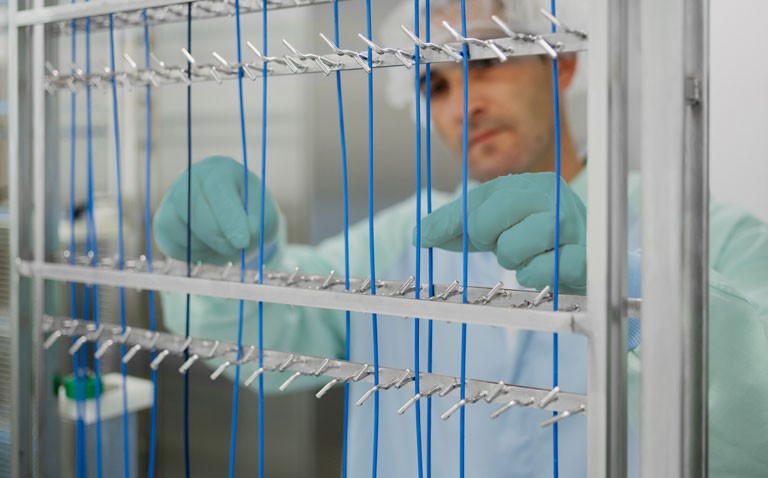Experts discuss the need for the health care sector to be included in the EU’s move toward a circular economy.
The healthcare industry creates more than double the amount of greenhouse gas emissions than the entire aviation industry. Yet few are holding the sector accountable.
A recent webinar entitled ’Towards a More Circular, Sustainable and Economic Health Care System in Europe’, offered an expert panel of key stakeholders, including representatives of the European Commission, European Parliament, European Committee of Regions, environmentalists, researchers, and industry to assess the health care waste problem, EU efforts to promote a circular economy, and offer a path forward for solutions.
The discussion is timely, as the EU’s Medical Device Regulation can have a profound impact on the way that hospitals across Europe can lower their carbon footprint while simultaneously reducing costs.
The following article includes edited versions of comments made by the authors at the 11 March 2020 webinar. The edits were made with permission of the authors to make the comments more suitable for printed format.
Can you frame the scope of the environmental problem caused by the health sector?

Dorota Napierska, chemicals policy and project officer, Health Care Without Harm Europe:
If the healthcare sector were a country, it would be the fifth largest emitter of global emissions on the planet. The healthcare sector within the European Union is one of the most polluting after the US and China. Evidence shows that more than 70% of emissions are driven by the supply chain, and it is not really such a surprise if we realise how the healthcare is currently dependent on the use of disposables.
The production, use, and disposal of healthcare products is emblematic of the linear economy. Alternatives to counter these unsustainable practices will be shifting more to a circular healthcare economy model built on principles of resource conservation.
A change to more sustainable and very often reusable products and services brings not only environmental, but also significant financial benefits for hospitals, and medical device reprocessing and remanufacturing have proven to play an important role here.
Does the EU’s MDR help to fix the problem?
Napierska: The real success and scaling up of reprocessing in the US started with strong regulation and strict guidelines. So, we are incredibly pleased with the adoption of the medical device regulation in Europe as it offers a path for hospitals to access environmentally preferable, more circular and lower cost reprocessed and remanufactured products.
In line with our global strategy, we believe that reprocessing and remanufacturing of medical devices can support hospitals on their way to maximise reuse, minimise waste, and save money. But this obviously needs support from national authorities, who must first make reprocessing and remanufacturing legal and possible.
What does your research find regarding the environmental impact of using remanufactured single-use medical devices, compared to using a virgin or original device each time?

Anna Schulte, lead researcher of a detailed life cycle analysis study published recently in the journal, Sustainability, Fraunhofer Institute for Environmental Safety, and Energy Technology UMSICHT:
Medical device remanufacturing might be the most promising circular economy strategy for single-use medical devices because they cannot be easily just reused directly by hospitals and cannot simply be recycled.
Our research team proved environmental benefits associated with remanufactured electrophysiology catheters in 13 out of 16 impact categories evaluated. We found hospitals save more than 20% from the use of remanufactured EP devices compared to exclusive use of virgin devices. Global warming emissions were cut in half when using remanufactured catheters compared to the virgin product. For abiotic resource use, a saving of 28.8% was calculated.
Our study provides information for policy and other decision-makers as it shows the transformative potential from linear to circular use of catheters by applying a remanufacturing system. In a fully circular production system, the carbon footprint could be reduced about 34.5% compared to linear production.
If 750,000 electrophysiological catheters are used in Germany every year, for example, complete collection of catheters for remanufacturing would save about 450 tonnes of CO2 equivalents per-year, in contrast to linear manufacturing.
What would you want Ministries of Health to know about your research?
Schulte: A legal obligation to remanufacture medical devices with high remanufacturing potential could be a key to achieving the circular economy and lead to more sustainability in the healthcare system.
Circular value creation is both environmentally and economically beneficial compared to linear value creation. Remanufacturing of single-use medical devices is an excellent example because it has the potential to preserve the product at the highest value, to be circular and reduce environmental impacts compared to virgin production, and to reduce environmental impacts on a systemic level.
Can you help readers to understand the EU’s new Medical Device Regulations, particularly Article 17 that govern the use single-use medical devices?

Erik Hansson, Deputy Head of Unit of Medical Devices and Health Technology Assessment, DG SANTE (Health and Food Safety), European Commission:
EU Member States may decide to allow reprocessing of single-use devices. If Member States permit reprocessing of single-use devices (SUDs), those devices must, like any other device, comply with the requirements of the EU Medical Device Regulation. Member States can however choose to derogate from these requirements with regard to devices that are reprocessed and used within a health institution provided the reprocessing is performed in accordance with Common Specifications adopted in August 2020.
Compliance with either of the above paths aims at ensuring that the safety and performance of the reprocessed device is equivalent to that of the original device.
Q: What are the options for EU Member State Ministries of Health and hospitals regarding the future of medical device reprocessing?
Hansson: They could also decide whether they want to introduce even stricter conditions or requirements than what we have in the Common Specifications. So, Member States have a few options to decide what they wish to do with this new legal framework. The Member States have the obligation to notify us whether they will permit reprocessing of single-use devices, and how they want to do so – whether they wish to use the Common Specifications, whether to allow outsourcing to external reprocessors, and so on.
The Common Specifications contain requirements for organisation and risk management, for instance when contracting an external reprocessor; staff, premises, and equipment; monitoring of changes made by manufacturers; determination of the reprocessing process; technical documentation and so forth. The Common specifications also include requirements for the procedures and steps of the reprocessing cycle; the quality management system, annual audits and reporting of incidents; and traceability, for instance, tracking reprocessing cycles and keeping records.
What is the Circular Economy Action Plan, and what else should healthcare entities know about the path toward a more circular economy?

Paola Migliorini, Deputy Head of Unit, DG ENV, the European Commission:
The Circular Economy Action Plan announces a set of initiatives for 2021 to ensure that all products on the EU market, including those used in the health sector, are sustainable by design, so that sustainability becomes the norm. And for that we need a product policy framework.
Many products break down too quickly, or cannot be easily reused, repaired, recycled, remanufactured, or refurbished. In healthcare, many are made for single use only. At least 80% of the products’ environmental impacts are determined at the design phase, so it is especially important to ensure that the design is optimal and allows for refurbishment and remanufacturing. We also need to address false green claims to ensure that there is no confusion when a product can claim to be “green”, and that there are clear lines of information for producers and consumers alike.
Currently there is no comprehensive set of requirements that ensures sustainability and the circularity in products, and we need to clearly act on that.
Under the Circular Economy Action Plan, we also want to take the lead on global efforts towards a circular economy. In February, we launched the Global Alliance on Circular Economy and Resource Efficiency to mobilise partners across the globe towards the development of a circular economy going beyond EU borders.

Is the European Union ready to do the heavy lifting to create meaningful change for the future of the planet?

Sirpa Pietikäinen, Finnish Member of the European Parliament, representing the European People’s Party. She is a member of the Economic and Monetary Affairs Committee and a substitute member of the Environment, and the Public Health and Food Safety (ENVI) Committee:
We would need four planets’ worth of resources by 2050 if we do not make drastic changes. So, the first and most important signal from the EU Parliament is that you need to have the right ambition level.
If you do not remember anything else that I have said, please remember that by 2050, all sectors, including the health sector, would need to produce the same or better welfare, the same or better income for your company, and the same or better quality for the customers and patients than today, but with one-tenth of the resources.
We must do this to stay within planetary boundaries that are absolute and non-negotiable. All products marketed in the EU should be durable, upgradable, reusable, repairable, and then recyclable at the highest level as parts of an equipment or as materials.
Do you see a connection between the COVID pandemic, climate change, and the EU’s move toward a circular economy?

Tjisse Stelpstra, Regional Minister, Province of Drenthe NL, Member, European Committee of Regions:
The COVID crisis is very urgent, and we must act on it without hesitation. Those working in healthcare know, maybe better than others, that this crisis is about health, it is about life. Let us hope it is a temporary crisis. There is no doubt that this crisis has had great effects on the world economy, and a recovery from this crisis is needed. But there is also another crisis, and it is also about health, and it is also about life, and that is the climate crisis. Where covid seems like an acute illness, the climate crisis is an insidious disease which more and more manifests itself as acute.
What can be done locally and regionally to help transform to a circular economy?
Tjisse: Local and regional authorities have an important role. They can help us to not only build a circular economy, but to intensify a circular society more broadly. I think that is what we need. Let us use this reality as a great opportunity for cooperation. There will also be skepticism and ignorance, and that is why we all – especially governments – have a lot of work to do. We must convince our citizens, our companies, our industries, and our clients about the importance of this transition to a circular economy and show them it is not only making the world better environmentally, but it is also the next step to more welfare.
So, I am an optimist, I am hopeful. COVID has shown us that we are resilient – in no time, we made a change to a digital economy, so I hope that we can in no time make the change to a circular society.
Tell us about the National Health System’s (UK) interest in the use of remanufactured single-use devices.

Alan Wain, Chief Operating Officer for NHS Supply Chain Coordination, National Health System, England:
Remanufacturing is quite sophisticated. Most of these devices cannot simply be put through a sterilizer; you have got to take them apart; you have got to reprocess them put them back together and make sure they are clinically safe to use again.
Just to put remanufacturing into context, if we examine our strategy to net-zero carbon emissions, the NHS needs to take out something like 16.5 million tonnes of carbon dioxide equivalent per year just from the supply chains.
One of the biggest contributors [of emissions in the NHS] is down our supply chains, our suppliers’ own carbon footprints, and that that accounts for about 4.5 million tonnes. Of that, 157,000 tonnes could be removed by using remanufactured or reprocessed devices, and another 202,000 tonnes from reused and refurbished devices.
To achieve our objectives, the NHS needs to be working with our strategic suppliers to achieve a major, seismic shift in carbon footprint reduction. We have been working with Vanguard as a strategic supplier, and we are doing a lot of engagement around the NHS for uptake of remanufactured devices.
It starts with the collection of the original device and sending it off to Vanguard’s remanufacturing unit to remanufacture them for reuse by the NHS. The next step is to get a bigger uptake of these devices within the NHS. There is, now, a small amount of uptake, but the ambition is to get to a much larger footprint wherein 40–50% of the devices being used are remanufactured.
Remanufacturing is an important part of our strategy – though it is not the only part of our strategy – and we are looking forward to working with our strategic suppliers to drive down the carbon footprint across the whole NHS.
What is at stake with the upcoming implementation date for the EU’s Medical Device Regulation?

Dan Vukelich, President and CEO, Association of Medical Device Reprocessors:
The provisions in Article 17 of the MDR represent one of the greatest opportunities for hospitals in Europe to lower costs, reduce waste, and reduce greenhouse gas emissions.
Unfortunately, medical device remanufacturing is currently not available in most EU Member States. So AMDR is urging Member States to act quickly to promote this circular economy solution for health. The practice has grown substantially in many countries. In 2019, our members served over 7600 hospitals and surgical centres worldwide, enabling them to participate in a circular economy for hundreds of types of medical devices labelled for single use.
As confirmed by the science presented, devices that are remanufactured have a substantially lower carbon footprint and use less resources.
Additionally, remanufacturing eliminated nearly 7 million kilos of medical waste from landfills and incinerators. This environmental contribution comes at no extra cost. In fact, medical remanufacturing has enabled healthcare systems to save over 446 million euros in 2019. This will potentially change when the MDR comes into force.
What EU Member States have opted-in to the MDR so far?
Vukelich: So far, the Netherlands and Belgium have allowed remanufactured products and notified the commission. I expect Germany soon, and I would hope before the May deadline that we are going to have some others that will report favourably towards allowing these products.
So, I hope each of us, from our individual standpoints, will encourage the European Commission and the European Parliament to continue down that path of promoting a circular economy and including healthcare within their scope. As we have learned from Anna Schulte’s research and from the example that Alan Wain and others have brought up, reprocessed and remanufactured medical devices are an immediate solution.










